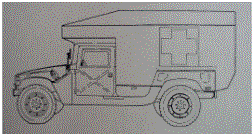|
This video was produced by the US
Army as a training aid for their medics..
It shows the safe techniques for
loading and unloading the M997 Ambulance.
The video clip may be freely
downloaded.
|

This ambulance is built on a HUMVEE frame
and is equipped with Kevlar armor protection for the crew and
patients. The armor protection is relative, not absolute. It is
somewhat effective against low-speed fragments. It is relatively
ineffective against high velocity small arms fire and not at all
effective against mines.
The M997 is capable of transporting:
 The sequence of loading
litter patients is right (passenger side) first, then left (driver
side). The sequence is: The sequence of loading
litter patients is right (passenger side) first, then left (driver
side). The sequence is:
-
Top right
-
Bottom right
-
Top left
-
Bottom left
The most seriously injured is always
loaded last and taken out first. This means that when the back of the
ambulance is opened, the most seriously injured patient will always be
on the left (driver side) and is the one removed first.
Patients are normally loaded head-first
into the ambulance. There are a number of reasons for this:
-
Oxygen equipment, when available, is
located at the front of the vehicle
-
Patients are less likely to become
nauseated if riding head first.
-
In the event of a rear-end collision, it
is safer.
There are some exceptions to the general
rules listed here.
-
Patients with chest or abdomen wounds,
and those recieving IV fluids should be loaded in the lower racks,
to facilitate IV fluid flow and attention en route by medical
personnel.
-
Those with wounds to one side of the
body should be positioned (feet first, if necessary) so that medical
personnel have access to the wound.
-
If patients are being picked up from
several locations, the ambulance shouldn't be unloaded and reloaded
just to maintain the severity of illness hierarchy. Just do the best
you can and let the receiving facility know who the most seriously
wounded are.
From Operational Medicine 2001 |


 The sequence of loading
litter patients is right (passenger side) first, then left (driver
side). The sequence is:
The sequence of loading
litter patients is right (passenger side) first, then left (driver
side). The sequence is: